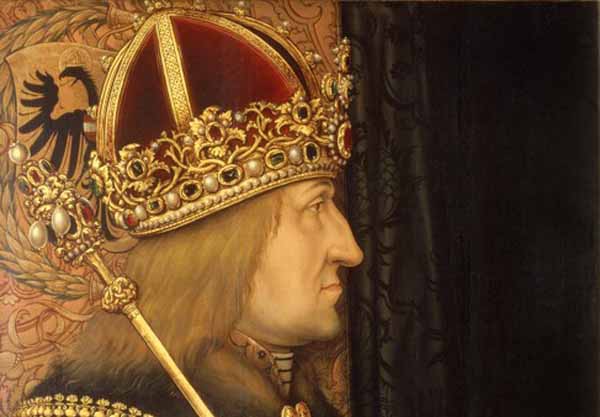Emperor Frederick III established the Habsburg dynasty of Austria as de facto hereditary rulers of the Holy Roman Empire.
Emperor Frederick III of the Holy Roman Empire (1415–1493) established the Habsburg royal family as the “House of Austria” and as de facto hereditary rulers of the Holy Roman Empire. Although Habsburgs had been elected emperor before, Emperor Frederick III was the first of an almost unbroken line of Habsburg succession until the fall of the empire. After inheriting some Austrian lands from his distant relation Albert II, Frederick used his stubbornness, perseverance, and luck to become elected Holy Roman Emperor, inherit more land, and create a strong position to be inherited by his son Emperor Maximilian I.
The Inheritance of Emperor Frederick III of the Holy Roman Empire
The young Duke Frederick of Styria was not an obvious choice to succeed his second cousin King Albert II as leader of the Habsburg family. But when Albert died in 1439, Frederick succeeded him as the senior Habsburg male. Mostly because the electors didn’t have any other viable candidate, Frederick was elected King of the Romans in 1440, a position that put him next in line to be elected emperor. And in 1452 he was elected Holy Roman Emperor, the only Habsburg ever to be crowned in Rome by the pope.
Frederick actually didn’t have that much wealth or land when he became emperor, due to the Habsburg practice of dividing land up amongst one’s heirs. But by outliving his other male relatives, Emperor Frederick III eventually inherited a great deal of Habsburg land. He had adopted Albert II’s posthumous son Ladislaus, and when he died in 1457, Frederick inherited the great Austrian lands the son had inherited from his father. Although Frederick inherited the area of Styria from his father, Ernest the Iron, he had to share his wealth with his hated brother Albert. But when Albert died in 1463, Frederick inherited his wealth and the rest of the Austrian lands. He was then able to pass these Austrian crownlands undivided onto his only son Maximilian I.
The Character of Emperor Frederick III of the Holy Roman Empire
Emperor Frederick III did not have a strong character and was not a magnificent ruler, but by being stubborn, single-minded, and phlegmatic he was able to survive his enemies, which ended up being the most effective way of defeating them. But he was not a great warrior like his peers, and instead was weak, intellectual instead of athletic, and more interested in keeping a cultured court than in fighting battles.
But Frederick III did believe in the special worth of the Habsburg bloodline and its sacred destiny to be emperors of the world. He had the initials AEIUO carved on everything, and understood them to mean a variety of grand sayings such as Austriae Est Imperare Orbi Universo (“The house of Austria is destined to rule the world”). He believed in magic, the occult, and astrology, and said that he could trace Habsburg ancestry back to such illustrious and legendary figures as Caesar Augustus and King Priam of Troy.
The Family of Emperor Frederick III of the Holy Roman Empire
It was of the utmost importance for Emperor Frederick III to sire an heir to keep the Habsburg bloodline and power going. He married Princess Eleanor of Portugal, and although they had a happy marriage they only had two surviving children, Maximilian and Cunegunde. Fortunately Maximilian survived to become the great Emperor Maximilian I. Furthermore, Frederick was able to arrange a marriage between his son and Duchess Mary of Burgundy, the wealthiest heiress in Europe, making the Habsburgs an even wealthier and more powerful family and securing their position in the future.
The Troubled Reign of Emperor Frederick III of the Holy Roman Empire
Emperor Frederick III had a reign troubled by strife and war. He warred with his own brother in his own lands until Albert’s death. He also warred with King Matthias Corvinus of Hungary, who kept trying to invade and take over Austrian lands. King Matthias finally took Vienna in 1485, causing Frederick to flee. While in exile, Frederick concentrated on arranging his son’s marriage and getting him elected as his imperial successor. When Matthias finally died in 1490, Frederick was able to get his Austrian lands back from Hungary but did not bother returning to Vienna. He died three years later, content that he was leaving his son Maximilian in a powerful position to succeed him both as ruler of Austria and as Holy Roman Emperor.
The Legacy of Emperor Frederick III of the Holy Roman Empire
Frederick was not a popular choice to succeed his cousin King Albert II as heir to the Holy Roman Empire, but he was the senior Habsburg male and there was no one else the electors could find to replace him. So he was elected Emperor Frederick III, and although not an imposing ruler proved to be good at surviving. He established the Habsburg dynasty as the hereditary imperial family, and was eventually able to secure much land and wealth for his son and heir Emperor Maximilian I.
Sources:
- McGuigan, Dorothy Gies. Habsburgs. Garden City, NY: Doubleday & Company, Inc., 1966.
- Wandruszka, Adam. House of Habsburg: Six Hundred Years of a European Dynasty. Garden City, NY: Doubleday & Company, Inc., 1964.
- Wheatcroft, Andrew. Habsburgs: Embodying Empire. London: Viking, 1995.





